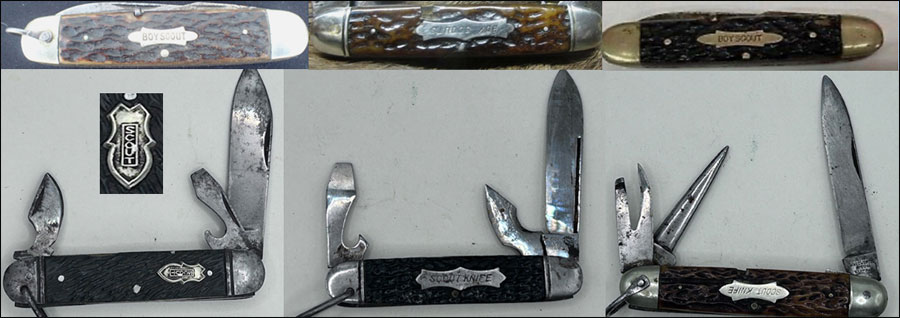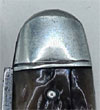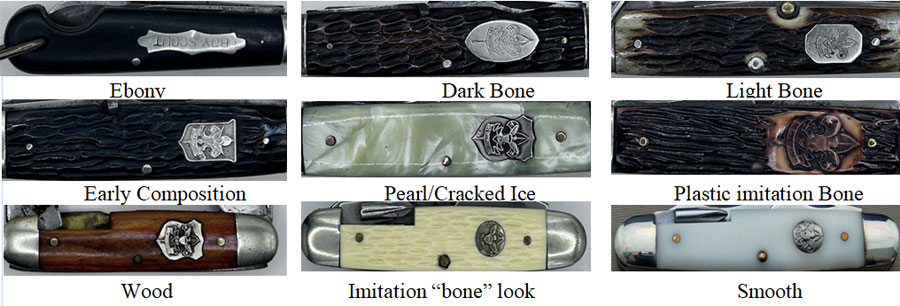(above) - About 1946, the BSA standardized the shield design. Different
manufacturers made knives, but the BSA did not advertise the name of the
manufacturer. You’ll have to look at the tang stamp to identify the maker.
The BSA was/is a huge organization. In the earliest years it had hundreds of
thousands of members that grew into the millions. A high percentage of
Scouts had a Scout knife. The good news for collectors is that knives are
available and often inexpensive. Some are more obscure, Cattaraugus and LFC
(Universal) can be scarce, but generally speaking most knives are available.
Shackles Most large (3 1/2 or 3 5/8”) Scout knives have a
shackle. The purpose of the shackle is to hang the knife from a belt. Early
images of Scouts show the knife suspended from the belt. Smaller knives
often do not have shackles, but I’ve found all kinds of exceptions,
especially with three blade whittling knives. Some companies (NYK) have
removeable shackles, the shackle can be pried apart and removed from the
knife. Others have permanent shackles, but you’ll find knives where the
shackle has been removed. When I catalog things I like to say unequivocally,
it’s this, not that. Shackles have been a
difficulty. Sometimes there is no documentation except that the knife
exists. |
 |
|
About Dating. I’m not a “stickler” about dates. I like a general idea of when something was made. The internet is full of dates when manufacturers
started and ended. There seems to be common knowledge about certain knives. Remington got a patent for the two piece can opener in 1927. Did they use it
before 1927 or after the patent was granted in 1928? Ed Holbrook in his
Official Scout Blades has what seems to be incredibly accurate dating
information. Perhaps it was gleaned from manufacturers records. I had no such access and recommend Ed’s book for those especially interested in very
specific dates. |
|
|
|
Scout Knife or Official BSA Scout folding pocket knife, What's the
Difference? |
|
|
There are dozens of unofficial scout knives, some very old, that say boy
scout and later just Scout. After the BSA was chartered by Congress, 1916,
it forced unlicensed manufacturers to stop using the wording Boy Scout. Many
simply renamed their knives, Scout knives. The four blade knife is still
known as the boy scout style. I’ve checked all my resources and cannot find
an example of an official BSA knife with the markings Boy Scout. Most
official BSA suppliers made generic boy scout style knives.
|
 |
Earliest knives say Boy Scout, after about 1917-18 the wording was changed
to Scout. There are dozens of these types of knives. I’m not attempting to
catalogue them, just showing a sampling. |
|
|
 |
|
|
|
These knives were competing with official knives, costs could be reduced by
having three blades. These knives are interesting and can be collectible,
but are not very much in demand to collectors. In the book
600 Scout Knives,
by Kerr there is an attempt to catalog the unofficial knives. In November
2024 Marvin Ratliff shows about 30 unofficial “scout” knives on
Boy Scout
Axes Hatchets and Knife Collectors website. In
600 Scout Knives by Kerr, he
catalogs about 70+ unofficial knives that have Boy Scout of Scout ID on the
handle. |
|
|

Lines on bolsters. When researching Remington I realized that early
knives had lines on the bolster, but the later ones didn’t. I reviewed other
knives. I discovered 4 blade Hammers (w/oval logo) have a line. Early
Dwight-Devine/Ulsters have a line. Full size LFC’s have the line. Cattaraugus do
not have a line. The earliest 1947 Camillus has a line, but later ones do not.
I’m wondering if the line was somehow specified by the BSA. Some of the early
unofficial knives have a line and others do not. I’m not sure what this
means. |
About Handles. Most early official scout knives had bone handles.
Although LFC (Universal) had a composition handle in the 1930’s and a pearl/cracked
ice handle was popular in the 1930’s and early 1950’s. Imperial had a
wooden handle in the 1950’s. Bone had to be cut, sometimes dyed and formed. It
was an expensive process. There could be color shade varieties ranging from
brown to black. After WW II most manufacturers started using plastic. It was
new, inexpensive and a lot could be done with it. |
 |
The color variations in the early bone handles make me question if the BSA had a
color specification. Perhaps the specification was simply “a bone”
handle. But how do we explain the early LFC composition? After the 1980’s the
style seemed to change away from the bone look to a more “chiseled” appearance.
Collectors seek knives with color handle variations, but I wonder if the
differences were specified.
About Can Openers Knife manufacturers seem to have had problems
with can openers. When you find a knife with a broken part, it’s usually the can
opener. I track three improvements in Remington’s, two in Hammers. Different
styles of can openers are something to watch for. |
 |
|
Condition-Desirability-Value There is information on the
internet regarding knife condition. Scout knives were made by the tens, maybe
hundreds of thousands. Some were made for just a few years, while others were
made for decades. |
 |
|
Condition is the most important factor in grading and valuing a knife. All
blades should be intact, no cracks in the handle, blades should have a good snap
to them, although oil will often rejuvenate deteriorated knives. Knives with
original etching on the blade, no sharpening or use will command the highest
values. Advanced collectors love boxes, the original box is desirable. An old
box might sell for more than a knife. |
 |